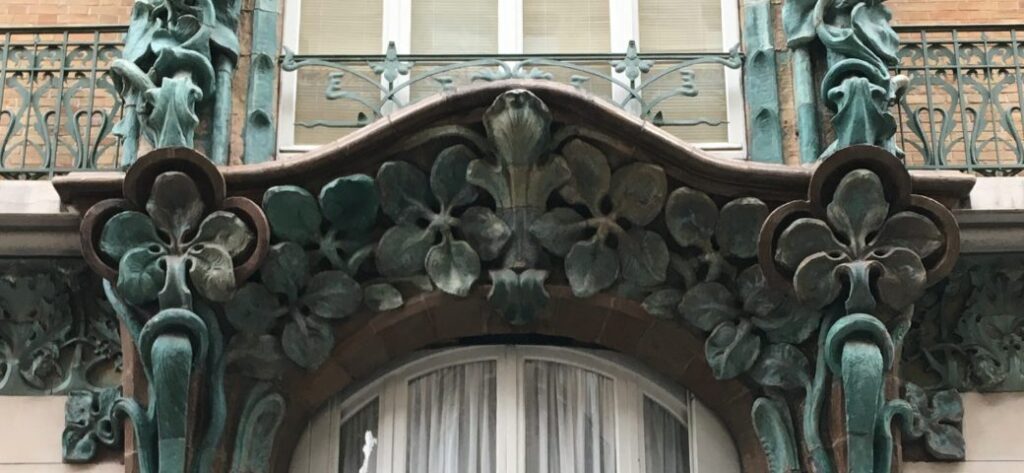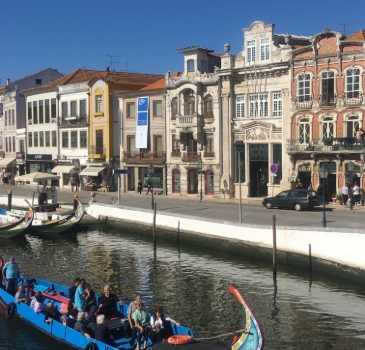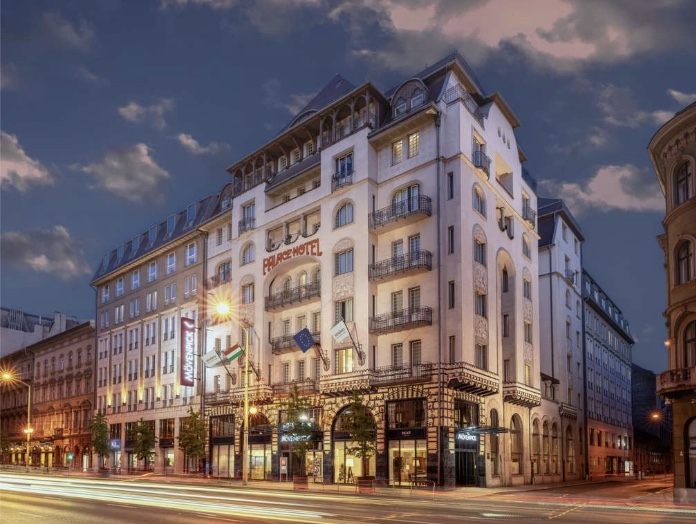Flourishing from roughly 1890 to 1914, Art Nouveau was an international artistic movement that embraced organic forms and rebelled against the rigid styles that dominated 19th-century art. Central to Art Nouveau was the sinuous line, mimicking the flowing curves of plants and flowers. This organic aesthetic found its way into various mediums, transforming everyday objects into works of art.
Art Nouveau in All Its Forms
- Architecture: Think of curving facades, stained glass windows depicting nature scenes, and wrought iron railings with intricate floral motifs. The Barcelona Metro stations designed by Antoni Gaudí are excellent examples of Art Nouveau architecture.
- Interior Design: Furniture with wavy legs and floral patterns, lamps resembling blossoming flowers, and wallpaper adorned with swirling vines were all hallmarks of Art Nouveau interiors.
- Graphic Design: Art Nouveau posters are known for their beautiful women with flowing hair, often surrounded by organic shapes and natural elements. Artist Alphonse Mucha’s theatrical posters for Sarah Bernhardt are iconic representations of this style.
- Jewelry and Glassware: Art Nouveau jewelry incorporated gemstones and pearls into flowing, nature-inspired designs. Louis Comfort Tiffany, the American designer, is renowned for his lamps with stained glass that resembled blooming flowers and dragonfly wings.
A New Dawn in Art and Design
Art Nouveau’s significance lies in its break from tradition. It paved the way for modern design by emphasizing functionality and beauty in everyday objects. The movement’s embrace of nature continues to inspire artists and designers today.
Cross-Pollination: The Global Inspiration of Art Nouveau
Art Nouveau wasn’t born in a vacuum. Its distinct style emerged from a rich tapestry of artistic movements and cultural trends across Europe and beyond. In England, the Aesthetic Movement, spearheaded by the likes of Aubrey Beardsley, championed the expressive power of line and a focus on beauty for beauty’s sake. These ideals resonated deeply with the emerging organic forms that would become central to Art Nouveau.
Meanwhile, William Morris’s Arts and Crafts Movement in England, with its emphasis on handcrafted objects and a return to traditional techniques, resonated with Art Nouveau’s rejection of mass-produced, soulless design. This yearning for a return to quality craftsmanship and a connection to the natural world became a defining characteristic of the movement.
Across the English Channel, European artists like Paul Gauguin and Henri de Toulouse-Lautrec were pushing boundaries with their bold use of line and flattened perspectives. Their experimentation paved the way for Art Nouveau’s expressive use of form, where natural shapes were reimagined and reinterpreted in a dynamic way.
Finally, a growing fascination with Japanese ukiyo-e prints further ignited the movement’s embrace of organic aesthetics. These woodblock prints, with their emphasis on flat color and stylized natural forms, offered a new visual language that resonated with Art Nouveau’s desire to break free from traditional Western artistic constraints.
Art Nouveau stands as a testament to the power of cross-pollination in the art world. By drawing inspiration from diverse sources across the globe, it created a truly international style that continues to inspire artists and designers today.
The Heart of Art Nouveau: The Undulating Line
The defining characteristic of Art Nouveau lies in its undulating, asymmetrical line. This line, often echoing the graceful curves of flower stems, swirling vines, and delicate insect wings, could be both elegant and graceful or imbued with a powerful, dynamic force.
Line Takes Center Stage in Graphic Arts
In the realm of graphic arts, this line reigned supreme. Form, texture, space, and color all played a supporting role, subordinated to the line’s decorative power. This can be seen in the flowing, organic designs of Art Nouveau posters, where figures and elements gracefully intertwine with the dominant lines.
A Fusion of Form and Ornament
Beyond graphic arts, the line’s influence extended to architecture and other three-dimensional forms. The entire structure became engulfed in this organic, rhythmic flow, creating a seamless fusion between structure and ornament.
Architecture: A Symphony of Lines
Architecture, in particular, exemplified this synthesis. Art Nouveau architects weren’t afraid to experiment with a variety of materials – ironwork, glass, ceramics, and brickwork. This approach allowed for the creation of unified interiors, where columns and beams morphed into thick vines with spreading tendrils, and windows served a dual purpose – providing light and ventilation while also functioning as organic outgrowths of the building itself.
This revolutionary approach stood in stark contrast to traditional architectural values, which prioritized reason and clarity of structure. Art Nouveau embraced a more fluid, organic vision, blurring the lines between structure and decoration, and ultimately leaving a lasting impression on the world of design.
Here’s the revised text focusing on some key Art Nouveau figures and their contributions:
Masters of Form: Leading Figures in Art Nouveau
The Art Nouveau movement boasted a wealth of talented artists and designers who left their mark on various mediums. Here are some of the most prominent figures:
- Charles Rennie Mackintosh: This Scottish architect and designer favored geometric lines in his work, particularly impacting the Austrian Sezessionstil style.
- The Belgian Architects: Henry van de Velde and Victor Horta, known for their sinuous and delicate structures, influenced the French architect Hector Guimard, another major contributor.
- Louis Comfort Tiffany: The American glassmaker rose to fame for his stained glass lamps featuring floral motifs and nature-inspired designs.
- Louis Majorelle: This French designer left his mark with exquisite furniture and ironwork pieces.
- Alphonse Mucha: The Czechoslovakian graphic designer and artist is renowned for his iconic posters featuring beautiful women amidst organic shapes and natural elements.
- René Lalique: The French artist’s work spanned glass and jewelry design, often incorporating nature motifs with innovative techniques.
- Louis Henry Sullivan: This American architect embraced Art Nouveau by incorporating plant-like ironwork details into his traditionally structured buildings.
- Antoni Gaudí: Perhaps the most singular artist of the movement, the Spanish architect and sculptor transcended a reliance on line. His work features curving, bulbous, vibrantly colored constructions that blur the line between building and organic form.
This list merely scratches the surface of Art Nouveau’s diverse talent pool. Each of these figures, and countless others, played a crucial role in shaping the movement’s unique aesthetic and lasting impact on the design world.
Art Nouveau’s Enduring Allure: From Decline to Revival
By the 1910s, Art Nouveau’s once cutting-edge aesthetic began to feel dated and restrictive. Artists and designers moved on to explore new styles, leading Art Nouveau to fade from the forefront of the design world. However, the movement’s influence didn’t disappear entirely.
In the 1960s, a wave of appreciation for Art Nouveau emerged. Major exhibitions at prestigious institutions like the Museum of Modern Art in New York and the Musée National d’Art Moderne in Paris brought the movement back into the spotlight. These shows, along with a retrospective on Aubrey Beardsley, a key figure in the Aesthetic Movement that influenced Art Nouveau, helped elevate the style’s status. No longer seen as a mere fad, Art Nouveau was recognized as a significant contributor to the landscape of late 19th-century modern art.
This renewed interest sparked a revival of Art Nouveau’s aesthetics in Pop and Op Art movements. The movement’s signature flowing organic lines found new life in the psychedelic fashion scene and typography. Rock and pop album covers and commercial advertising embraced these floral motifs, breathing new life into Art Nouveau for a new generation.
Art Nouveau’s journey from groundbreaking style to temporary decline and ultimate revival serves as a testament to the cyclical nature of artistic trends. While it may have fallen out of favor for a time, Art Nouveau’s enduring influence and ability to be reinterpreted by new movements solidify its place as a significant chapter in the history of art and design.
Art Nouveau enthusiasts are invited to embark on a unique European adventure that showcases the movement’s finest works. These private tours, loved by Americans and other international travelers, provide an in-depth look at the beauty and intricacy of Art Nouveau in iconic cities across Europe. Discover more about these unforgettable experiences in Private Tours for Art Nouveau Enthusiasts: A Unique European Adventure Americans Love.







